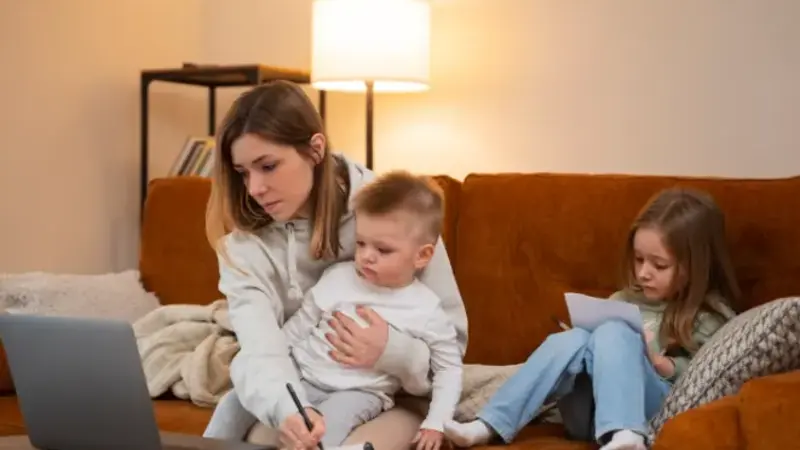More and more screens are entering the daily lives of children, especially in lieu of online learning and virtual classrooms. Putting parents in a dilemma to balance significant learning against device time. Technology may offer engaging and instructional experiences, but high exposure may merely distract children.
Finding the golden mean is what matters. In this article, practical strategies for managing screen time without sacrificing educationally-deficient. Family-unbeneficial activities will be explored, including insights on off-screen activities such as helping children print out for parties.
Understanding Screen Time: What Counts and Why It Matters
Screen time consists of every hour a child spends using mobile devices such as smartphones and tablets and computers, or televisions. They differ in measuring the quality of screen time. For example, some kinds of screen time are passive watching videos, while others are classified as active and instructional. Such as working with math apps and attending virtual classes.
The American Academy of Pediatrics recommends that children ages 2-5 have no more than 1 hour of quality screen time a day. Lesser time, generally, for older children means more sleeping hours and physical activities, and all other daily routine activities.
Key Takeaway: Screen time is not a bad occurrence. It is all in the quality and amount, along with everything else happening during the day.
Creating a Screen Time Plan That Will Work for Your Family
A structured screen time plan helps create healthy habits. Here’s how parents can develop one:
- Give your routine an assessment: For a week, note your child’s screen time to catch possible trends.
- Set rules: When and where, as well as how screens can be used, e.g, not using devices during meals or an hour before going to bed.
- Co-view and co-play: Do activities with your child on a digital medium for a clearer understanding and much better involvement in that activity.
- Parental Control Tools: Such apps include Google Family Link, which is supposed to help restrict the hours of usage.
Involve Your Child. Kids will follow rules designed by themselves.
Key Takeaway: Planning screen time cooperatively creates ownership, equity, and continuity.
Putting Learning Ahead of Entertainment
Prioritize educational content over purely entertaining screen use. Choose age-appropriate apps and platforms that make learning fun and learning interactive.
Some top options include:
- Khan Academy Kids: Early learning for reading and math.
- PBS Kids Games: Interactive games based on popular shows from PBS.
- Duolingo: Language learning for the older child.
It has been shown that having students present what they’ve learned after using their favorite educational app helps reinforce the learning and deepen it.
Key Takeaway: Making sure that time spent in front of a screen is, in priority, only for using the device for development.
Encouraging Off-Screen Activities That Reinforce Learning
Off-screen activities are essential for hands-on learning and skill development:
- Make print invitations for pretend parties: Writing invitations for parties or family dinners is writing, design, and social skills rolled into one.
- Activities: Volcano models or growing crystals are examples of homemade science experiments. Makes science real and fun.
- Board games and puzzles: They develop an ability to carry out characteristics of problem solving, memory making, and teamwork.
Every single everyday chore, such as helping to prepare a meal or organize shelves, provides many opportunities for learning experiences.
Key Takeaway: Onscreen and offscreen play, as well as real-world tasks, supplement digital learning to ensure growth in cognitive and life skills.
Being a Role Model: The Parents’ Influence on Screen Habits
Children learn healthy habits by observing their parents. You can model responsible screen use by:
- Limiting your own device use during family time.
- Explaining your own screen habits and purpose.
- Choosing shared screen activities like family movie nights or cooperative games.
Key Takeaway: Children adopt lasting digital habits by watching and emulating their parents’ behavior.
Using Screen Time to Build Family Connection and Collaboration
Screens can foster bonding instead of isolation. Try:
- Making digital scrapbooks or family photo albums.
- Playing cooperative video games.
- Watching a documentary together and then discussing it.
- Planning a virtual call with relatives.
Key Takeaway: Shared screen activities strengthen family relationships and turn digital time into meaningful interaction.
Beating Screen Time Challenges: What to Do When It Derails
In every scheme, there is going to be a reality when some children would not follow the rules, sneak in little devices, and be overly dependent. These plans include dealing with such crises:
- While the remaining consequences further reinforce these learning limits, they now see it as a rule of what it means to their screen usage, and respond calmly.
- Revise and reread with a child about setting rules so that surfing can be done without hitches to the plan from everyone who is using it.
- Include a few screen-free spaces in the area, for example, bedrooms, cars, and mealtimes. So these are the few areas and really designated times, without screens, encourage family stuff, then the healthy habits.
- Use visual schedules and timers to guide the younger kids. Things like these charts and timers, once again, help kids learn about limits without intervention at home. In turn, keeping them more independent and not fighting about the whole screen time issue.
Takeaway Message: The most interesting thing is that a person can actually be kept in tune with other people while communicating with another one.
Frequently Asked Questions (FAQs)
Excessive screen time for kids?
It is advised that children be given a certain amount of time for the appropriate age and number of hours of screen exposure, especially to children under five, while children above five years should. However, balance their activities with other activities of different dimensions to replace sleep, physical play, or learning opportunities for all the hours spent in front of screens.
Is screen time for learning purposes?
Indeed, what really transforms a screen time experience becomes education into learning when the right age development interactive content is used. Making use of educational apps and videos is for learning that has to makes it more effective in sharpening the skill sets.
What can you learn beyond a screen?
Hands-on projects, reading, and activities outdoors, along with the creative activities such as making invitations, teach children life skills like creative imagination, problem solving, etc. These activities are necessary to be undertaken beyond a screen in supplementing digital learning for an ideal, rounded experience.
How to definitely eliminate surreptitious screen time?
Set rules about keeping device monitoring, and initiate healthy conversations regarding healthy screen behavior, such as healthy screen time. Much simpler and routine will make children more likely to follow rules and abide by boundaries.
Should toddlers be banned from screens?
A full ban is usually unnecessary. Limiting experiential mediated exposure and having the child view it with the parent while learning helps facilitate access to off-screen activities, but safety as well.
Final Thoughts
Scoring well on the balance between screen time and learning does not mean reducing screen use altogether, but means using it wisely. The combination of quality digital content and off-screen time will foster a child’s development. Healthy habits, some sharing and working with their child, and loads of encouragement and support from educational content are the control variables to consider in creating a well-balanced home life amidst parents. Learn more.

